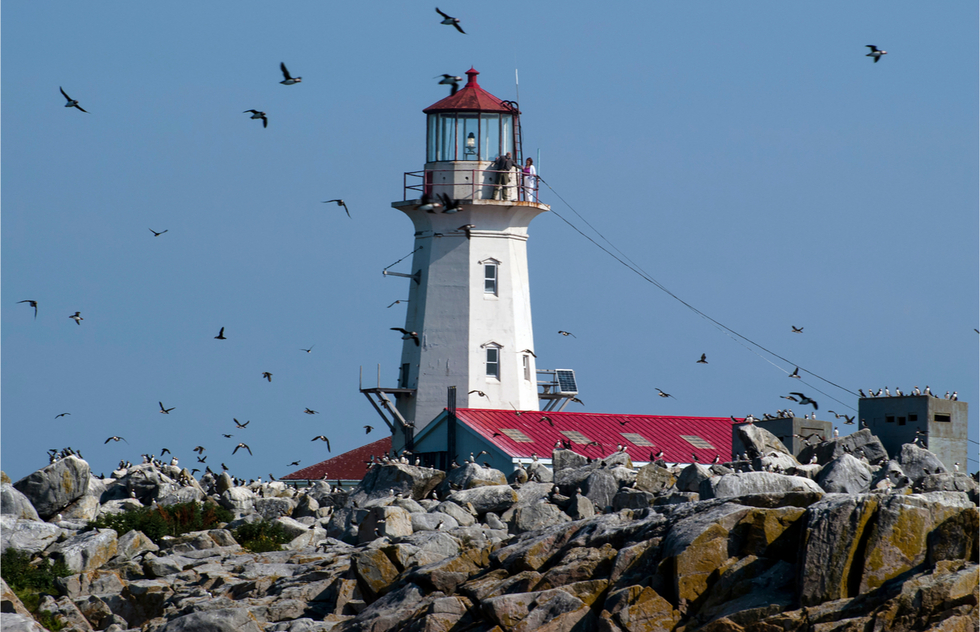Unlike its neighbor Nova Scotia, Canada, Maine doesn’t maintain, advertise, or market a “Lighthouse Trail.” Various travel writers and bloggers have cobbled such itineraries together, though—which isn’t surprising, since the state has some of the best lighthouses in the United States. Most were built of stone in the early to mid–19th century, and nearly all were automated in the 1960s or 1970s with very few exceptions. (Today no keepers live full time in any Maine lighthouses.) To see them all, you’d need to drive the coast bottom to top—in other words, follow the chapters of this book in geographical order—and also be in possession of a boat.
Let’s forget about the boat for a minute and concentrate on those most easily seen by car; I’ve sprinkled references to Maine’s most visible lighthouses throughout this guidebook, but henceforth, a quick primer on connecting the dots and seeing them one by one, beginning with the southern coast. (Note: If you’re tacking on a side trip to Portsmouth, New Hampshire, you’ve got a shot at even adding a few more lighthouses to your “seen-in-lifetime” list—see the end of this article for how to do that)
THE SOUTHERN COAST: Almost from the moment you cross the state line in Kittery, you’re on the scent of our Lighthouse Trail. Make a beeline for Fort McClary Historic Park, about a mile and a half east from downtown Kittery on the back road to York (Route 103). From the park, overlooking Portsmouth Harbor, you can view squat, gray-granite Whaleback Light. It’s not much to look at, though a private boat would help you get closer; public access to the lighthouse grounds is not permitted, however.
A few miles north of Kittery, detour off Route 1 to York Beach and head for Long Sands. Here, from the comfort of nothing more than a blanket or beach chair, you can—with good eyes—spy two lighthouses at once.
The first one, Nubble Light (pictured below) is obvious at the northern end of the beach. Sticking far out on a promontory, it’s the archetypal Maine light. For a closer look, drive to the northern end of the beach and hang a right, then drive the winding cape road to the turnoff for Sohier Park (parking is free). Here, from a rock or bench, you can get almost close enough to the fabled light to touch it—don’t try however; a dangerous narrow passage of water separates the viewing area from the rock-bound lighthouse. Snap a photo, then head up the hill for an ice-cream cone at Brown’s, again keeping your gaze fixed on the lighthouse as you eat.
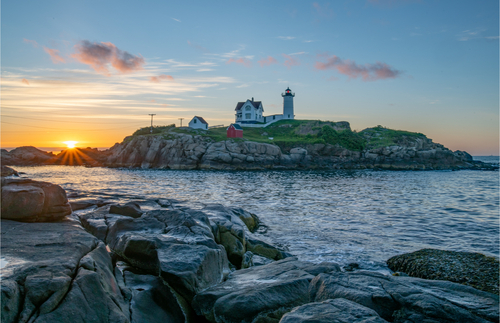
The other lighthouse visible from Long Sands, the tall, slim, ghostly Boon Island light, demands a perfectly clear day and binoculars or exceptional vision. Gaze out to sea, roughly in the middle of the stretch between both ends of crescent-shaped Long Sands, and its hazy outline may appear to you. Though nearly 10 miles offshore, the granite tower stands more than 13 stories tall—New England’s tallest—which is why it can be seen.
Tiny, wind-swept Boon Island itself has an appropriately murky history: When a British ship ran aground here in 1710, survivors resorted to cannibalism for nearly 3 weeks to survive until a member of the party somehow sailed ashore and fetched help. Author Kenneth Roberts wrote a popular novel, Boon Island (1956), fictionalizing parts of this incident. Incredibly, the barren rock and its lighthouse was still inhabited as recently as 1978, when one of the worst winter storms in New England history destroyed all the outbuildings and part of the tower, where the keeper’s family cowered for several days awaiting rescue. Soon afterward, it was automated.
It’s a bit farther north to the next light. The small Goat Island Light lies just off the lovely hamlet of Cape Porpoise, north of Kennebunkport. (From Dock Square in the center of Kennebunkport, follow coastal Route 9 about 2 1/2 miles north and east to find the village.) The light has a storied history, including its use as a Secret Service command post protecting the family compound of President George H. W. Bush; a keeper who did a 34-year stint of duty on the rock; a caretaker who died in a boating accident in 2002; and Maine’s last lighthouse-keeping family, the Culps, who departed the light in 1990 and turned it over to automation and the care of the Kennebunkport Conservation Trust. The Trust maintains the 25-foot tower and keeper’s house and plans to restore the property further in the future. Boat visits are welcome.
At the mouth of the Saco River, where the big river enters the Atlantic at the Biddeford-Saco line, the cute little Wood Island Lighthouse and its keeper’s house still guard this passage—though you’d never know it, as the light’s almost impossible to view, except by boat. The light has a rich history, however, including tales of ghosts, murder most foul, and a keeper’s dog smart enough to ring bells by himself. The Friends of Wood Island Lighthouse offer summertime boat tours to the island; otherwise, its premises can’t be visited by the public.
GREATER PORTLAND: Greater Portland contains perhaps the finest—and most visited and photographed—lights on the whole of the Maine coast.
To view Cape Elizabeth Light (pictured below), the southernmost light in the Portland area, head straight for Two Lights State Park. (There were previously two working lights here; one was phased out). The light-keeper’s home is now privately owned, but this lighthouse has a rich lore, including daring rescues of shipwrecked sailors in the boiling, stormy sea and the work of painter Edward Hopper, who featured the light in several early-20th-century paintings. It is still an important signal on this rocky part of the coast. If you’re hungry after viewing it, be sure to drop by the outstanding Two Lights Lobster Shack for a bite, and also visit the small souvenir shack on the rocks.
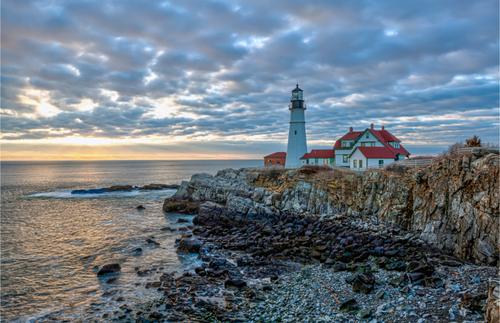
Just to the north, Portland Head Light has lovely proportions, an 80-foot beveled tower, a handsome keeper’s home (now a small museum), and a scenic position on a cliff before the horizon and the Atlantic. This is one of the very best lighthouses in Maine to view with the family—and one of the most popular and often photographed, as well. (Don’t come here for solitude.) Hundreds of thousands of visitors come each year to the free park from which it can be viewed, just off Shore Road in Cape Elizabeth. There’s also a gift shop.
From Portland Head Light, you can get a very good view of another lighthouse just offshore: the often-overlooked (probably due to its crude looks) Ram Island Light, built of Maine granite in 1905.
Next up, reachable by following South Portland’s Broadway to its end, is the Spring Point Light, an amusingly shaped light that somewhat resembles a fire hydrant. But take it seriously: It guards the heavily trafficked passage between Portland Harbor and the so-called Calendar Islands, a passage critical to oil and freight transport into and out of Maine. The light is set out at the end of the narrow stone breakwater, and can be walked up to and viewed but not entered except during special open houses held periodically, when you may view the keeper’s room, which is slowly being outfitted with period furnishings. There’s a museum, the Portland Harbor Museum ([tel] 207/799-6337), on the land side of the breakwater with plenty more information about the area. The light is also adjacent to both the pretty campus of Southern Maine Community College and the ruins of Fort Preble, good places for a picnic and a walk.
Nearby around the point, the Portland Breakwater Light—locally known as “Bug Light”—is a smaller, squatter version of the Spring Point light sitting on land that was once an important shipbuilding complex. A small, free city park surrounds the light.
FREEPORT TO MIDCOAST: From either Bath or South Freeport, you can take a boat tour to view the attractive high rock housing Seguin Island Light a few miles off Popham Beach. Contact Fish’N’Trips Charters (tel. 207/841-7977), which runs a few trips a month through the summer, or the Maine Maritime Museum (tel. 207/443-1316), which offers daily cruises past the light. Due to the heavy fogs that frequently move into this area, the house sports Maine’s strongest (and most valuable) lens; it’s 12 feet high, and has been operating since 1857, the same year the keeper’s home and stone light tower were also constructed.
Smaller, weaker Pond Island Light, Cuckolds Light, the Perkins Island Light, Ram Island Light, and the mainland-based Squirrel Point Light are all located in the same general vicinity as Seguin, and they can also be viewed on the Maine Maritime Museum cruises or other charter runs from the Boothbay Harbor waterfront. Squirrel Point’s light can also be hiked to via a rough trail that begins off Bald Head Road in Arrowsic.
Also in Arrowsic, some of Doubling Point Light’s grounds (see below) are free to roam. To reach here, cross the huge bridge from Bath, make an immediate right onto Route 127 south, and follow signs to the Doubling Point Road turnoff on the right. The light is connected to the keeper’s quarters by a long causeway, which is closed to the public. Two small related lights, known as the Range Lights, are housed in octagonal wooden towers near the Doubling Point grounds; these lighthouse grounds are also free to visit, and the towers are architecturally singular on the coast, though unsigned and a bit difficult to find. The Maine Maritime Museum’s special lighthouse cruises (see above) often pass by this set of lights.
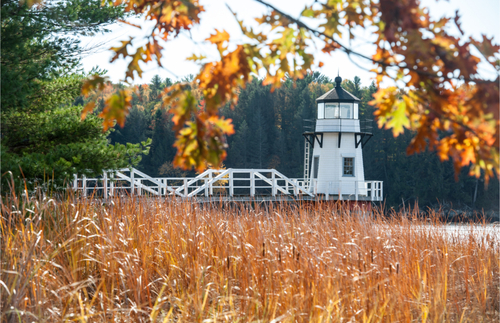
From the pier in Boothbay Harbor, it’s easy to visit the handsome Burnt Island Light and its attractive complex of outbuildings: Catch an excursion from the pier, then settle in for one of the twice-daily summertime tours. Plan ahead, however; the tours take 2 to 3 hours apiece. Now owned by the state of Maine, the complex, still active as a navigational aid, is also home to a program of nature, arts, and even music courses—a real success story.
Before leaving Boothbay Harbor, you may wish to detour down the long peninsula to West Southport (take Route 27 to the turnoff for the village) to get a view of offshore Hendricks Head Light, now privately owned and beautifully restored.
Finally, there’s the Pemaquid Point (in Bristol) and its museum and the Marshall Point Lighthouse (in Port Clyde) and its museum. Offshore on Monhegan island, there’s the Monhegan Island Light and its museum (open July–Sept; tel. 207/596-7003). It’s well worth a look if you’re out on the island, and makes a fine, fitting end to this section of our ad hoc lighthouse trail.
PENOBSCOT BAY: The Midcoast region harbors plenty of lights, though many are small and posted on offshore rocks, thus inaccessible (and unviewable) by car. However, the squat Owls Head Light, still active, sits on a promontory in Owl's Head State Park; it can be viewed by anyone who can wrangle a parking spot in the lot. Volunteers from the American Lighthouse Foundation are on hand a few day a week to offer tours, by donation. With a long walkway and set of stairs connecting the keeper’s house to the tower, this is one of Maine’s most visually pleasing lighthouses (see below).
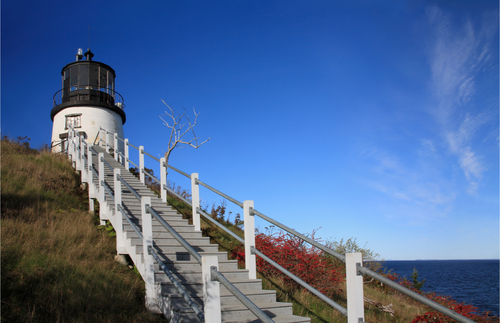
The southernmost light of the two in the city of Rockland is known as Rockland Harbor Southwest Light, and this light is fascinating: It’s the only one in Maine that was built by a private citizen. A local dentist constructed the light as both an aid to ships and a kind of homage to the other Rockland light (see below), and it began blinking on and off in 1987; today it’s an official navigational light and still privately held. From downtown Rockland, head south about 2 miles on Route 73 and hang a left onto North Shore Road.
The Rockland Breakwater Light sits at the northern edge of the harbor, sitting atop a handsome brick home about a mile out on a rugged stone breakwater; it’s easily viewed from the Samoset resort complex, but the grounds are only open to the public during summer weekends.
Rockport’s Marine Park is a good spot to look out at the attractive keeper’s house and its Indian Island Light; however, the light itself no longer functions. Just north in Camden, the Curtis Island Light is quite attractive—it sits on an island, now owned by the city—but can only really be seen well from the deck of a sightseeing charter or windjammer cruise leaving from the harbor. Just north of Camden in Lincolnville, stand on the ferry dock for a look at the Grindle Point Light, with its unusual squarish light tower—or, better yet, hop the ferry for an up-close look; it docks on Isleboro nearly beside the lighthouse. The light is part of a public park that includes a small museum built as a memorial to sailors.
Continuing north, pull off Route 1 at signs for Stockton Springs if you want a look at the tiny Fort Point Light, still active and now a state historic site. It’s not the most impressive of the state’s lights, however.
Castine is already attractive enough, but the presence of the Dice Head Light makes it even more so. Besides the keeper’s house (privately owned), the property features an unusual rough, conical stone tower (though the actual light is no longer atop this interesting structure). Simply follow Route 166 to its very end for a look. There’s a foot trail to the water (with steps) that’s open to the public, but be respectful of the keeper’s house; it’s private property.
There are three lighthouses on or just offshore Deer Isle, but one is no longer active and the other two can only be seen from a boat cruising off the island’s back shore.
Finally, the Robison Point Light on Isle au Haut is visible from the route of the Stonington mailboat ferry. Friends of Isle au Haut Lighthouse offered docent-led tours prior to COVID and a 2021 renovation and plans to start them again.
MOUNT DESERT ISLAND & DOWNEAST: Mount Desert Island and its surrounding islands are home to very few lights that can be visited or viewed by the public. One that can is the Bass Harbor Head Light, a famed symbol of Acadia National Park, on Mount Desert’s western lobe, down Route 102A past Southwest Harbor. The complex (pictured below) includes a cylindrical light tower, simple keeper’s house, triangular fog signal, and even a barn.
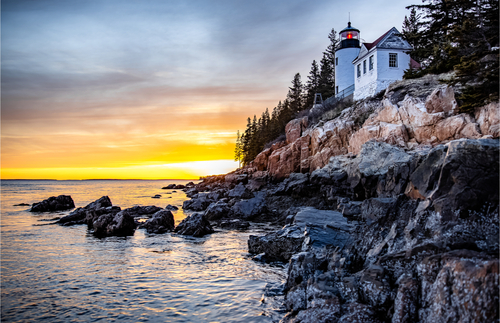
From Bass Harbor, head for another light that can be visited by the public: the Burnt Coat Harbor Light (also known as Hockamock Head Light). To get here, however, you’ll need to catch a ferry from Bass Harbor to Swan’s Island. The squared brick tower and keeper’s home were built in 1872.
The downeast section of the Maine coast is rife with little ledges and lighthouses, often steeped in fog and usually off-limits to the public (and too far offshore or too indistinct to be seen anyway). The inactive Winter Harbor Light can be distantly glimpsed from the Schoodic Peninsula loop road.
The slim stone tower of the Petit Manan Light near Milbridge pokes an impressive 120 feet above the surrounding sea. However, it’s off-limits and difficult to see anyway. You can get a better look at it while taking a tour of the Maine Coastal Islands National Wildlife Refuge.
Finally, there’s the West Quoddy Head Light in Lubec, part of the state park of the same name, which is America’s easternmost point. There’s a museum on the lighthouse grounds, open daily from spring through Columbus Day. Check it out, then sit awhile to reflect on all you’ve seen on your lighthouse tour.
A LITTLE SOMETHING EXTRA: If you decide to begin your Maine coasting in Portsmouth, New Hampshire, you can take a side trip to the coast and glimpse a few more lighthouses. The cast-iron Fort Point Light (also known as Portsmouth Harbor Lighthouse), part of the state’s Fort Constitution Historic Site (www.portsmouthharborlighthouse.org; tel. 603/534-0537), is on Route 1B near the Wentworth by the Sea resort. It can be viewed from the historic site—which is free to enter—from May through October, but can only be entered on Sunday open-house days during that season; admission is $10 for adults and $6 for children.
There’s also the brick White Island Light, offshore in the Isles of Shoals and too far to be seen except when taking a cruise of the islands. Contact the Isle of Shoals Steamship Co. (tel. 603/431-5500) about periodic lighthouse cruises of the area.
For more on Maine’s (and New Hampshire’s) lighthouses and preservation efforts, contact the American Lighthouse Foundation (tel. 207/594-4174).
Note: This information was accurate when it was published, but can change without notice. Please be sure to confirm all rates and details directly with the companies in question before planning your trip.





